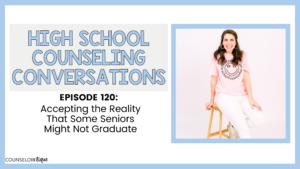I want to tell you about my first week of “Senior Meetings” as we start out the school year.
My senior meetings are timed at 30 minutes each, and I try to do about six each morning and catch my breath in the afternoon. I love the conversations that I get to have with these twelfth graders. Some are decisive, and others have no clue what’s next. Both types of meetings are extremely fun for me.
I have students applying to two-year and four-year colleges, students heading to work with a certification of some sort, and other students joining the military. These meetings are very student and parent-driven as I answer any questions they might have specific to that student’s plan. You will never run out of things to talk about during these meetings!
I want you to run your senior meetings like the boss of a school counselor that you are! So here are some tips for how I hold productive senior planning meetings that I hope you can incorporate into your high school counseling program!

Scheduling Senior Meetings
In terms of scheduling the meetings, I let students sign up for a meeting with me first. I create a digital sign-up through Sign Up Genius. If they don’t sign up for a time, I assign them a time because it’s important for me to meet with each of them and make sure they have a plan to be college or career ready.
Flow of My Senior Meetings
In my particular meetings, here is how my flow usually goes:
- I ask where the student sees themselves in 5 years. This usually is not a question they’re expecting, but it gives me an idea of the direction they see themselves going in.
- We then talk about where they are in that post-secondary planning process. If it’s college, where are they in the application process? If it’s work, do they already have a certification or a job secured? If it’s military, have they taken the ASVAB or met with a recruiter yet?
- If they’re headed to college and we’re checking on the status of that process, we look at the schools they are applying to or thinking about applying to. Are they using the Common App, or Coalition App, or are they applying directly to the institution? I show them how to send their transcripts to these schools or how to request them from me. I make sure they know how to send their SAT and ACT test scores through the respective testing agencies.
- If they qualify for free or reduced lunch, I make sure they know what benefits come with that regarding fee waivers for tests and application fees.
- Then, we talk about financial aid. I walk them through our state scholarships, letting them know about where they stand with those at this point when we look at GPA, test scores, and class rank. I show them our school’s resources for where we keep our scholarships and how they can access them. Here is a FREE STARTER SCHOLARSHIP SPREADSHEET for you, your students, and your parents to use to keep organized and motivated in the financial aid process!
- I let them know about important dates coming up like any College Essay Writing Workshops, district financial aid nights, College Application Day, or classroom lessons coming up about help with financial planning, etc.
- I give them a copy of their unofficial transcript, a flyer with all upcoming important dates, and a handout with the state scholarship information. Before they leave, they have to complete a digital survey that our district asks for (basically a summary of what we talked about and what their plans and interests are).
Resources for Senior Meetings
I created this Senior Year Planning Guide for those students headed to college and to hand it to those who need help during their senior meetings. They can use it to manage their stress, stay organized, and keep everything in one place as they’re applying for college.
- an intro letter from YOU, their school counselor (or add your own if you don’t like mine!)
- a small group interest form (this would be a great way to see if they need some extra help in a small group counseling setting dealing with Stress Management or First Generation College Going help)
- a passwords page– to keep track of ALL of those usernames and passwords (students can NEVER remember them!)
- a deadlines page– fill in the month and use the box for big deadlines
- to-do list– has 10 lines for immediate to-dos and the other side of the sheet has some space for coloring and doodling to relax in the midst of all of this craziness!
- a college search sheet– helping a student identify some of the key things they’re looking for in a college
- a college list– a table for the college’s name, the type of decision they are applying under (early decision, early action, regular decision), a checkbox for sending their transcript, and a checkbox for sending SAT/ACT test scores… this one also has space for doodling!
- a testing summary– students can write out all of their SAT and ACT tests and scores and superscore it at the bottom… it also has room for filling in upcoming test dates
- an application to-do list– tells students step by step HOW to apply for college… I find this is confusing for many students!
- financial aid terms to know– just a quick rundown of some words and acronyms in the financial aid process
- financial aid– bullet points of what you need before you fill out the FAFSA
- brag sheet and essay brainstorm– this will help students brainstorm what is unique about them and try to pinpoint some highlights to bring out on their college essays
- resume– to fill in some of the things they’ve been involved with from clubs to sports to work to musical talents
- questions to ask an admissions counselor– self-explanatory… may be helpful on a college tour or thinking about what questions to ask a potential college interviewer if applicable
- the importance of self-care– last but not least! some tips and a checklist for staying positive and caring for themselves during a stressful season






